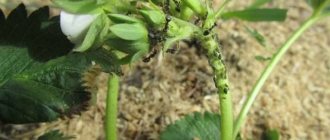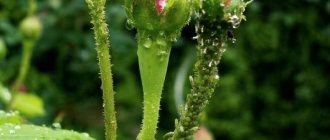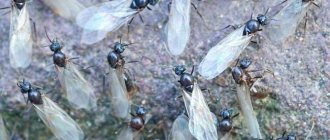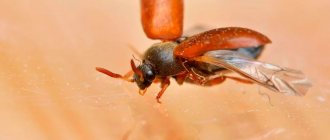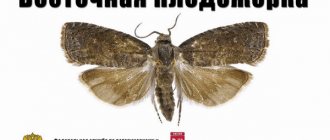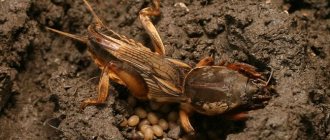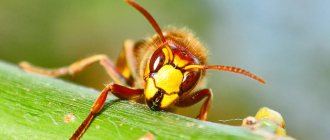The appearance of ticks on the site is one of the most pressing problems for summer residents after garden pests. Feeding on human and animal blood, the insect can infect serious diseases during a bite, such as tick-borne encephalitis and borreliosis. These diseases can lead to disability and even death.
The article gives advice on how to deal with ticks in your summer cottage in order to reduce the risk of being bitten, without harming beneficial insects, plants and pets.
Reasons for the appearance of ticks in a summer cottage
If there were no ticks on your summer cottage previously, this does not mean that they will not appear on it this year. There are several factors for the appearance of bloodsuckers:
- When a tick has nothing to eat, it is forced to go in search of food. The adult arachnid is very slow. In a day he can crawl up to 10 meters.
- Thus, the bloodsucker can enter the territory of the dacha, migrating in search of the next victim.
- The neighbor's plot and distance from the forest play an important role. If the area is located near a forest or there are ticks at a neighboring dacha, there is a risk of parasites.
- Migration of harmful insects with the help of animals is possible. But their numbers will be insignificant.
- If the dacha was purchased recently, it is impossible to immediately find out about the habitat of ticks. The insect transforms from an egg into an adult within 1.5-2 years. During this time it does not appear to the eye. The massive invasion of pests in early spring indicates their presence since last year.
Description of garden mites
Ticks belong to a group of very small arachnids. The body length ranges from 0.03 mm to 1.0 cm in males, from 0.05 mm to 3.0 cm in females. The body is round, covered with setae or sometimes microscopic warts, divided into 2 parts - the cephalothorax and abdomen. There are 2 pairs of simple eyes on the head. With its piercing-sucking mouthparts, the mite pierces the tissue and sucks out plant juice. 6 pairs of appendages that act as legs help the animal move. The legs are five-membered. Hence the name - arthropods. The body color is red, brown, gray-green, yellowish-green or green and depends on the color of the main host.
How to find ticks on a property?
First of all, you need to make sure that there is a pest in the garden or vegetable garden. You can find ticks in your summer cottage using a product made of white fabric. Ideally, flannel material or a waffle towel is suitable for the device. This will make it easier for ticks to cling to the fabric.
For the best effect, you need to rub the material on your body so that the canvas becomes saturated with sweat, then tie it to both ends of a meter-long handle or stick. You will get a device that looks like a flag. You need to move it slowly in the direction of grass growth. The manipulation is carried out several times. After each inspection, it is necessary to inspect the canvas for the presence of ticks.
If this method helps to detect arachnids, it is necessary to take measures to destroy the mites.
Signs of a plant being damaged by garden mites
Common signs of damage by garden mites are wilting of the plant, curling of the leaves without visible damage. When carefully examining the leaf blade of garden plants, on the underside of the leaf blade, under a magnifying glass, you can notice tiny yellowish or white dots - puncture sites of the mite. Individual points in the shortest possible time merge into spots clearly visible to the naked eye, and the shoots with leaves are still shrouded in a thin, barely noticeable web, sometimes as thick as felt. If there is a large accumulation of pests on the underside of the leaves, you may notice very small grayish dry skins (like dandruff). These are the remains of the larvae after molting. The web serves as protection for the pest from the effects of natural enemies and drugs. Each species has distinctive signs of the damage it causes, which allows you to immediately determine what type of mite has settled on the plants.
Signs of plant damage by spider mites
The most famous and widespread are spider mites (Tetranychidae). There are more than 1,200 species of spider mites, found everywhere, including Antarctica. Very small insects. Males 0.3-0.6 mm, females up to 1.0 mm. The yellow-green color matching the color of the foliage allows ticks to lead a secretive lifestyle. Leaf blades damaged by spider mites become brownish-brown, curl and fall off. In autumn, the female lays up to 10-12 eggs per day.
Over the course of a year, in regions with a long warm period, up to 25 generations of spider mites hatch. The eggs are attached by a web to the stems of weeds. Spider mites can destroy up to 80% of the crop (for example, Grape itch, or Felt mite). According to experts, the pest is a carrier of gray rot diseases and viral infections of agricultural and ornamental crops.
Plant buds affected by bud mite. © otokkatieto
Signs of gall mite infestation
Anatomically, gall mites (Eriophyidae) differ from brown and spider mites in the absence of hind legs. This species has only 2 anterior pairs, the posterior ones are atrophied. Favorite garden crops are cherry plum, pear, plum. Damaged leaves form growths of galls, in which the mite is located “with all the comforts.” The leaf itself becomes covered with pimples and curls. The tick lives and reproduces in the galls throughout the warm season. If gall “houses” are visible in a dried, unrolled leaf, it means the plants are affected by gall mites. If such branches are found on trees and bushes, they must be carefully cut off and burned. The presence of a gall mite is also indicated by “witches’ brooms”, which are bunches of sterile shoots with underdeveloped leaves.
Signs of brown garden mite infestation
The brown tick's favorite habitats are garden crops, with particular preference given to apple trees. The tick has a reddish-brown color. Females lay eggs in the buds and by the end of flowering, young females lay new eggs of the next generations. By the end of summer, the leaves are entangled with thousands of almost invisible mites, which destroy the tree, dehydrating it. The plant weakens and dies.
Protecting the site with folk remedies
Traditional methods of getting rid of ticks do not affect the health of humans, animals and plants, but their use over large areas will take a lot of time.
There are several simple folk methods that will help get rid of ticks in the country:
- Garlic tincture : you need to peel a large head of garlic, grate it and pour 2 liters of water into it. It is recommended to leave the liquid in a dark place for a day, then strain the infusion and add another 2 liters of water. The area needs to be sprayed several times until the insects disappear. The same infusion can be made from the onion. The effect will be identical.
- Parasites are afraid of moisture , so it is recommended to spray the garden and vegetable garden more often.
- Boric acid or soda : One of these powdered products should be sprinkled on areas with uninvited inhabitants.
- Cyclamen roots : you will need to place 100 g of tubers in 1 liter of boiling water. The roots are cooked until they are softened. The finished broth must be cooled, then strained.
Some summer residents remove ticks from the site mechanically. This method is carried out in the same way as when searching for ticks. Early in the morning, when the dew has dried, a white cloth is passed over the grass and the procedure is repeated for 2 weeks. Collected insects must be burned after each mechanization.
Distribution area of ticks
In Russia, the most common species is the garden spider mite. The distribution area covers the chernozem and non-chernozem zones of the European part of Russia, Transcaucasia, and southern regions. The brown fruit mite has moved further to the northern regions, but under the conditions of a limited warm period it manages to form only 1-2 generations. As a species, in the south brown garden mites are the most harmful and can form 4-5 full generations during the warm season. Gall mites are less common and most often breed on certain garden, forest and park crops.
Getting rid of ticks in the country using chemicals
Chemical treatment of a summer cottage against ticks with toxic substances can harm the health of a person or animal if you overdo it or do not follow the instructions, but its effectiveness is obvious. The drugs are recommended for use over large areas. When treating an area yourself against ticks, you should remember about precautions and protective equipment, such as:
- latex gloves;
- headdress;
- clothing covering all parts of the body;
- respirator.
To avoid picking up ticks, clothes are sprayed with repellent sprays.
Chemicals are divided into several groups:
- For a small summer cottage, a product based on pyrethroids . It is considered the safest. The drug is based on chamomile. Despite the gentle components, the effectiveness of the chemical is in no way inferior to those listed below.
- Organophosphorus - destroys insects over large areas and quickly disintegrates in the soil. The downside of the drug is toxicity. If the substance gets on the mucous membrane or skin, burns and poisoning will occur.
- DDT (dichlorodiphenyltrichloromethane) is considered one of the most effective means of eliminating parasites, but has a significant drawback - absorption into the soil. This affects the yield of country crops. The drug is recommended for use in extreme cases.
Today, the following insectoacaricidal agents are popular, which are worth noting:
- Ram - This is one of the most effective chemicals against ticks, but it is dangerous not only for human health, but also for birds and animals. It should be used with caution only once a year.
- Force Site 25% emulsion concentrate affects the nervous system of insects. Destroys not only ticks, but also mosquitoes, flies, incl. larvae.
- Dobrokhim FOS is valid for 1.5 months. The concentrate is dangerous for bees. If there are beehives on the site, you should treat the area in the late evening or early morning.
- Medilis Cyper lasts about 3 months. It is suitable for both open areas and indoors.
Each of the above drugs has instructions that must be strictly followed, otherwise the effectiveness of the chemicals will not be effective.
How dangerous are ticks?
Arachnids are carriers of diseases dangerous to humans:
- tick-borne typhus;
- fever;
- tularemia;
- Lyme disease;
- encephalitis
But not every type of tick is a disease spreader. Only 7 groups of these animals are dangerous to people. The most aggressive: encephalitic, subcutaneous, scabies, argas, ixodid.
Other arachnids, when they come into contact with human skin, only lead to itching and irritation.
Most mites are harmful to plants and animals. The most malicious garden parasite is the spider mite, which feeds on the juices of garden crops and carries root and gray rot. It can affect plants of various types, including indoor flowers.
There are mites that devour certain vegetables and fruits: apple, plum, nut, grape, pear, linden.
As a rule, they settle under leaves, on flowers and fruits. Arachnids suck out all the beneficial substances from crops, which causes wilting, a decrease in yield, and then the death of the plant organism. Attention : if you find a tick bite, you should immediately consult a doctor so as not to contract the disease.
What should you not do when fighting ticks on your property?
How to get rid of ticks in a summer cottage without harming pets, birds and beneficial insects? This is not an easy task. It is necessary to take into account all the nuances of their extermination. One wrong action can ruin the entire fight plan or harm innocent living beings.
- There are times when chemicals are used at a dacha without removing unnecessary trash and thickets where insects live. Ticks can burrow deep into debris or vegetation to escape chemicals. The result will be zero. Therefore, tick treatment cannot be carried out until all debris has been removed from the area. It is recommended to dispose of it, for example, by burning it.
- Do not increase the intended dosage for the chemical. An increased concentration of toxic substances can lead to acute soil poisoning and spoil the future harvest.
- Also, one of the common mistakes is incorrectly selected time and weather conditions. Do not treat contaminated surfaces in windy or rainy weather. There should be no precipitation 3 days before and after spraying. Otherwise, the poison will be washed away, and all efforts will go down the drain. Before using medications, you should check the weather forecast.
- You cannot cultivate a summer cottage earlier than 40 days before harvest. When spraying with poisons, the chemical gets onto crops and trees. It needs to be neutralized under the influence of precipitation and watering, otherwise severe intoxication will occur.
Level of harmfulness of ticks
Is this microscopic pest really that scary? A simple calculation shows that if only 50 larvae survived from each female in the offspring (and she is capable of producing 200 eggs), then with 15 generations per year the number of individuals would cover the globe with a layer of 2 meters. Therefore, even a small initial number of mites in the garden can give rise to a sudden epiphytotic outbreak of pest reproduction and lead to the death of infected crops in the shortest possible time. Bud mites are especially dangerous for plants. Their number in one kidney ranges from 100 or more individuals. Therefore, mites are considered one of the most dangerous plant pests.
Is it worth contacting the company?
Of course, treating an area yourself from ticks is several times cheaper than calling experienced specialists, but where is the guarantee that the insects will be completely exterminated?
If you are very afraid of suffering from a tick bite at your own dacha, but do not have the strength, time or desire to exterminate them yourself, then it is better to call a specialized service for exterminating ticks. Experienced workers will find the location of the insects and destroy them with special chemicals using professional equipment.
But before contacting a company, you need to make sure of its professionalism. You can inquire about a company that interests you - ask your friends or read reviews about the company on the Internet.
